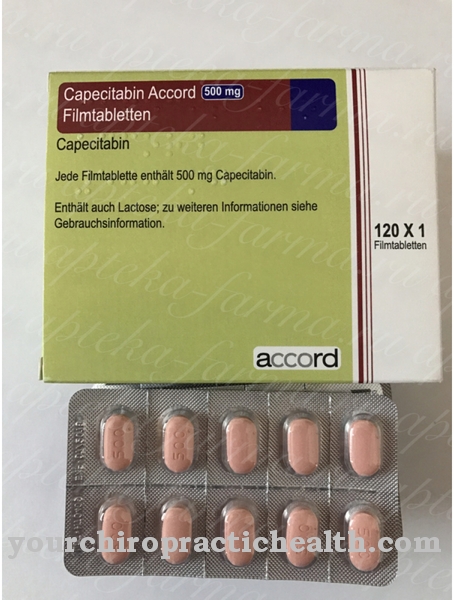Apremilast is a drug that is used under the trade name Otezla® in the treatment of plaque psoriasis and active psoriatic arthritis. It is an active ingredient from the group of PDE4 inhibitors. The effect of apremilast is based on the inhibition of the enzyme phosphodiesterase-4.
What is apremilast?

Otezla® is used for moderate to severe plaque psoriasis. It is a condition that causes red and scaly patches on the skin. Furthermore, the drug apremilast is also used in those associated with psoriasis Inflammation of the joints, called psoriatic arthritis.
Otezla® is used in patients for whom other systemic therapies do not have the desired effect. Otezla® can also be used in combination with other disease-modifying anti-inflammatory drugs. The drug with the active ingredient apremilast requires a prescription and should only be used under the supervision of an experienced doctor. Treatment is initiated gradually. Apremilast is available as a film-coated tablet. It was first approved in the USA in 2014 under the trade name Otezla®.
Pharmacological effect
Apremilast inhibits the enzyme phosphodiesterase-4 and thereby increases the intracellular cyclic adenosine monophosphate (cAMP), molecules that are biochemically derived from adenosine triphosphate (ATP). They are used for cellular signal transduction.
This increase results in a reduced formation of the inflammatory mediators in the inflammatory cells. The intracellular enzyme Phoshodiesterase-4 (PDE4) plays an important role in the natural defense system of the human body, the immune system. It triggers the production of cytokines. These are messenger substances that are involved in inflammatory processes and processes that trigger psoriasis.
By inhibiting PDE4, the concentration of these cytokines in the body is reduced. Inflammation and other symptoms of psoriasis are reduced by this inhibitory effect. Apremilast is an oral low molecular weight PDE4 inhibitor. It acts intracellularly through the modulation already mentioned. In the network of pro- and anti-inflammatory mediators, PDE4 is a dominant PDE. The inhibition leads to downregulation of the inflammatory reaction. Presumably the pro and anti-inflammatory mediators are involved in the clinical picture of psoriasis and are manipulated positively by apremilast.
In the context of clinical studies in patients treated with apremilast, a significant modulation was found. However, there was no complete inhibition of plasma protein levels. In addition, apremilast reduced the epidermal thickness in the affected skin areas in the patients. Furthermore, the infiltration by inflammatory cells and the expression of proinflammatory genes were significantly reduced. No prolongation of the QT interval was observed in the patients at doses of 50 mg twice daily.
Medical application & use
Psoriasis is also called psoriasis. This skin disorder can also affect nails or joints. This chronic inflammatory skin condition is not contagious. One of the causes is the genetically inherited disposition for psoriasis. Symptoms include the reddish inflamed areas of the skin, itching and silvery-white flakes of skin that can be several centimeters in size. This disease is usually chronic or with recurring attacks.
The effectiveness of the drug apremilast in psoriasis and psoriatic arthritis has been demonstrated in clinical studies. Apremilast was used as a monotherapy and as a combination therapy with low molecular weight DMARDs, a basic therapy for inflammatory rheumatic diseases.
As a result, treatment with apremilast led to a significant improvement in the symptoms and signs of psoriasis or psoriatic arthritis. The response data in the group of patients with monotherapy and the group of patients with combination therapy were approximately the same. A therapeutic benefit arose for various manifestations of psoriasis. The quality of life of the patients could be significantly improved by apremilast.
Risks & side effects
The most common side effect of Otezla® affects the digestive system. Diarrhea and nausea are very common symptoms. Upper respiratory tract infections, headaches, especially tension headaches, are also common side effects.
Apremilast should not be used during pregnancy. Women should also use efficient contraceptive measures while taking it. Otezla® was approved because the benefits outweigh the risks. The side effects are mostly mild to moderate. The drug can be taken orally, is available up to 30 mg.




























.jpg)